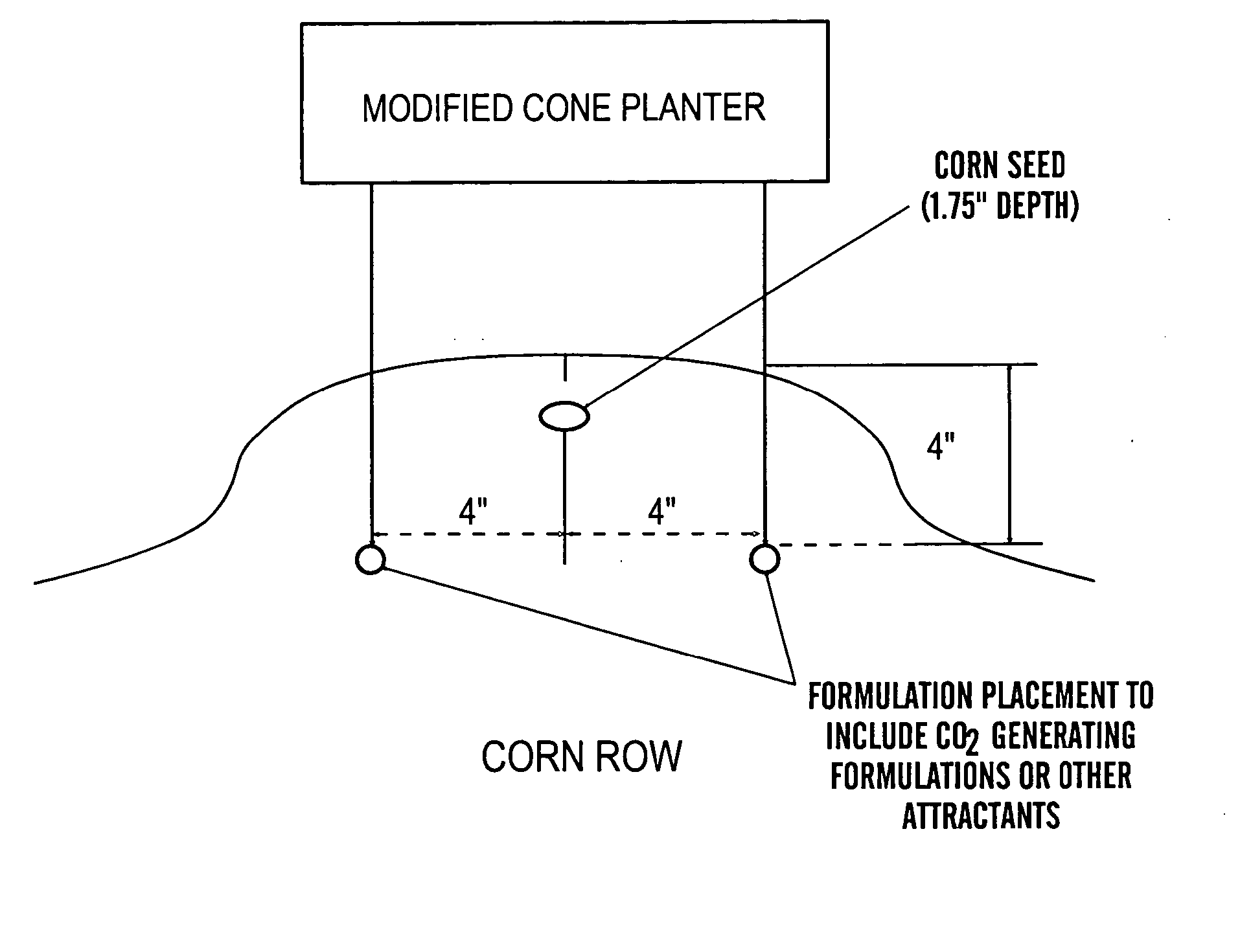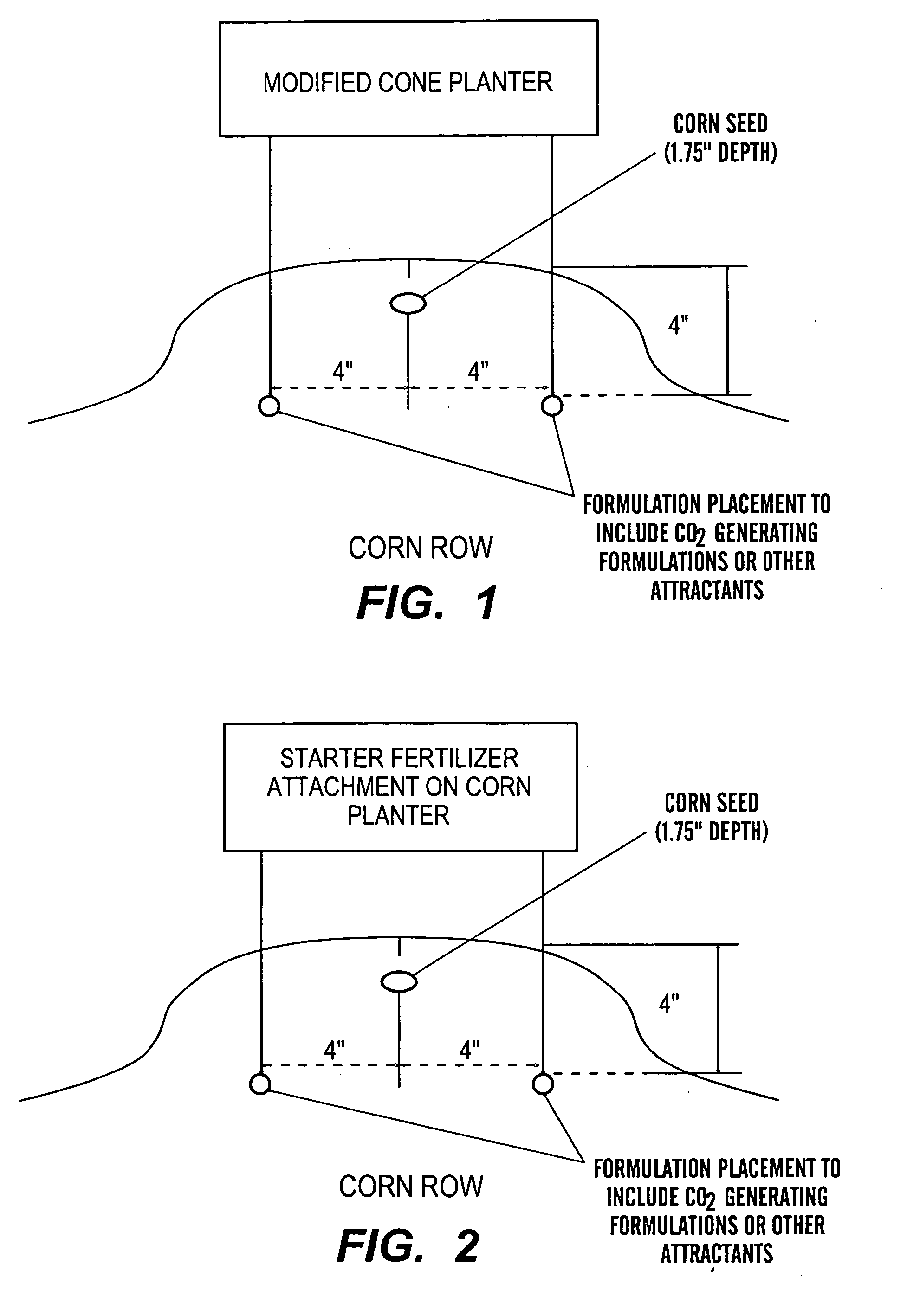Method and device for attracting insects
a technology of insects and attracting devices, which is applied in the field of methods and devices for attracting insects, can solve the problems of long time required for termites, environmental problems, and inability to be easily identified by investigators, and achieve the effect of being readily availabl
- Summary
- Abstract
- Description
- Claims
- Application Information
AI Technical Summary
Benefits of technology
Problems solved by technology
Method used
Image
Examples
example 1
Formulation 1 in Jar Traps at 1 Meter
Composition of Formulation 1 (Dried Spent Brewer's Grain): Spent brewer's grain obtained from a local brewery was spread out on trays and allowed to air dry overnight. The dried spent brewer's grain was then added to soil that contained 20% moisture (12 grams (g) dried spent brewer's grain per 100 grams moist soil).
Trap Design: Jar traps were constructed from 16 ounce polyethylene jars with plastic screw caps. Each jar was drilled with 36 evenly-spaced holes (3 mm diameter) to allow volatiles to diffuse out of the trap and to allow termites to enter. A cylindrical basket was constructed for each cup trap from plastic fencing to facilitate removing the trap from the soil. Baited traps were prepared by placing 300 grams of Formulation 1 in a jar trap. Unbaited traps were filled with 300 grams of soil (20% moisture). A disk of cardboard (8 cm diameter) was placed in the top of each trap (baited and unbaited), covered with a thin layer of soil, a...
example 2
Formulation 2 in Jar Traps at 1 Meter
Composition of Formulation 2 (Dried Ground Germinated Corn Seeds): Corn seeds were soaked in soapy water overnight, rinsed well and germinated in a covered plastic tub containing moist germination paper. After 3 days of germination, the germinating corn was ground to meal using a kitchen food processor, then spread out on trays and allowed to air dry overnight. Dried, ground, germinated corn seed (12 grams per 100 grams soil) was added to soil that contained 20% moisture.
Trap Design: Jar traps were constructed from 16 ounce polyethylene jars with plastic screw caps. Each jar was drilled with 36 evenly-spaced holes (3 mm diameter) to allow volatiles to diffuse out of the trap and to allow termites to enter. A cylindrical basket was constructed for each cup trap from plastic fencing to facilitate removing the trap from the soil. Baited traps were prepared by placing 300 grams of Formulation 2 in ajar trap. Unbaited traps were filled with 300 gr...
example 3
Formulation 3 in Jar Traps at 1 Meter
Composition of Formulation 3 (Whole Dry Malted Barley): Whole dry malted barley was obtained from a local brewer's store. The whole dry malted barley was then added to soil that contained 20% moisture (12 grams whole dry malted barley per 100 grams moist soil).
Trap Design: Jar traps were constructed from 16 ounce polyethylene jars with plastic screw caps. Each jar was drilled with 36 evenly-spaced holes (3 mm diameter) to allow volatiles to diffuse out of the trap and to allow termites to enter. A cylindrical basket was constructed for each cup trap from plastic fencing to facilitate removing the trap from the soil. Baited traps were prepared by placing 300 grams of Formulation 3 in ajar trap. Unbaited traps were filled with 300 grams of soil (20% moisture). A disk of cardboard (8 cm diameter) was placed in the top of each trap (baited and unbaited), covered with a thin layer of soil, and the lid was then screwed onto the trap.
Field sites: ...
PUM
 Login to View More
Login to View More Abstract
Description
Claims
Application Information
 Login to View More
Login to View More - R&D
- Intellectual Property
- Life Sciences
- Materials
- Tech Scout
- Unparalleled Data Quality
- Higher Quality Content
- 60% Fewer Hallucinations
Browse by: Latest US Patents, China's latest patents, Technical Efficacy Thesaurus, Application Domain, Technology Topic, Popular Technical Reports.
© 2025 PatSnap. All rights reserved.Legal|Privacy policy|Modern Slavery Act Transparency Statement|Sitemap|About US| Contact US: help@patsnap.com



